How to Use Google Search Console to Build an Impactful SEO Report
Part One of a series on reporting best practices
Marketers rely on metrics and KPIs, whether it’s to manage expectations, track progress, or just establish a common internal vocabulary to discuss projects and goals. Understanding the sources and limitations of each type of data point you collect directly informs the insights you can gather–and the steps you can take to continually improve your SEO and other marketing efforts.
Use this article to review the fundamentals and a starting point for enhancing your reporting capabilities. Consider which elements are leveraged in your existing reports, or if you’d like to design new data dashboards that better align with your marketing objectives.
Organic Search Data
With organic search, you can learn how new and existing customers find your site via search engines like Google. You want to serve a healthy blend of branded keywords to improve the user experience for your existing customers and audiences, and target non-branded keywords to drive new business. Search engines give you free visibility in front of your target audience; this is part of why SEO is vital in digital marketing.
Google is by far the most widely used search engine. You can use Google’s organic search data to understand how users find your site, engage with your brand, and seek information in general. Google provides detailed metrics via Search Console to quantify user searches and how your site performs within the search results.
Using Google Search Console (GSC), you can access a variety of data points that illuminate different aspects of the search experience, such as Clicks, Impressions, Click-through Rate, and Rankings. Each metric listed below provides a nuanced look at your visibility in search results.
Clicks
Clicks help you understand which pages and keywords drive the highest traffic volume. Do not make the mistake of considering clicks in terms of their absolute value alone. Low clicks and clicks trending upward MOM or YOY can represent an opportunity for improvement, particularly if they have high impressions–denoting high general public interest–or a “striking-distance” position for your brand.
Impressions
Use impressions as a leading indicator of opportunity.
In the early stages of an SEO strategy or site life, impressions may experience growth far before the clicks do. Pages need to get indexed and earn their rankings; before they are on page 1 and you start to see substantial click-throughs, you won’t see useful click numbers. You will, however, be able to tell how many times these pages appeared in the SERPs.
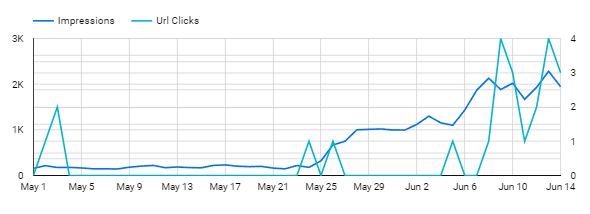
Click-through Rate
Click-through-rate (CTR) points to organic search conversion in a way that tends to be most accessible across business units. As a result, it’s a popular metric to use in reporting. CTR is a direct reflection of how attractive the search result is. Metadata and Rich Snippets come into play here, as they can potentially double the click volume of a keyword in the same position.
You can also examine whether CTR is higher for specific keywords due to features in their SERP. For example, results for some keywords may contain Search Ads, Shopping Ads, Local results, People Also Ask, and other features that may steal clicks away from the standard organic search results. You may choose to focus more energy on SERPs with less clutter, or you may leverage these other SERP features in your strategy to feature your brand more prominently on the screen.
In the example below, GreatPetCare.com ranks in position 1 for “best wet cat food” and “healthy wet cat food.”
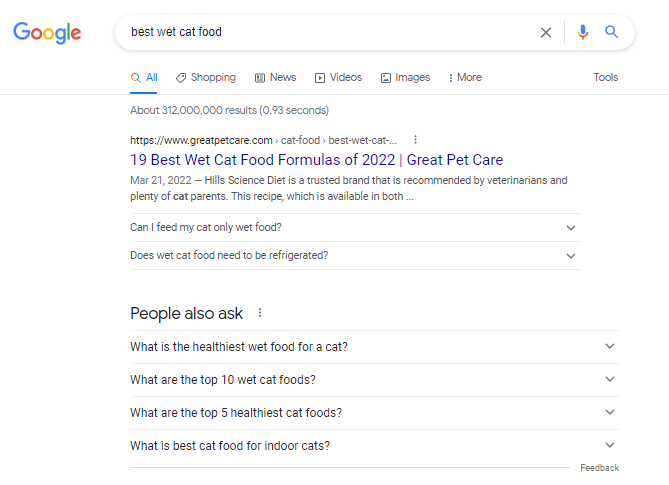
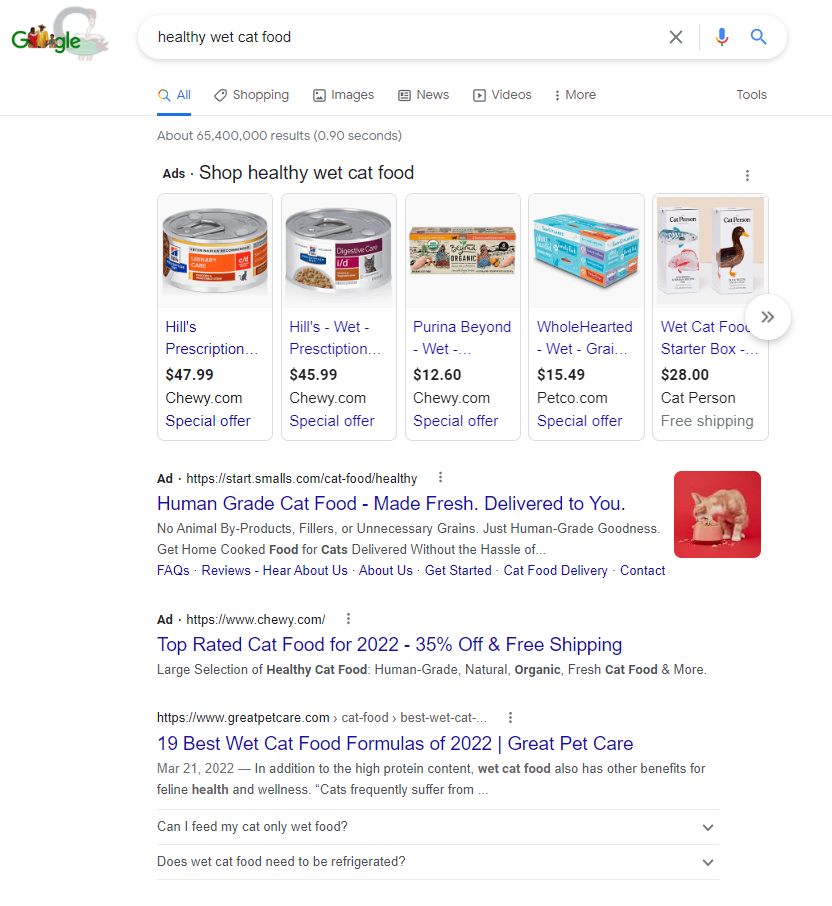

Rankings (“Average Position” in Search Console)
The higher you rank on SERPs for keywords relating to your brand, the more likely you are to meet your target audience precisely where they need your expertise most. Your rankings for specific keywords are displayed under the “Average Position” metric in Search Console.
The optimizations you make, from keywords through UX, drive your rankings in the SERPs. Looking at which pages rank highly in the SERPs–and how users engage with them, as evidenced by other metrics like clicks–can help you understand what’s driving traffic and where there’s room for growth.
Rankings are especially important for this growth consideration. For example, if you are ranking just outside of the top ten pages on a SERP, look at the associated pages and keywords–and consider how to optimize them further to realize their full potential. Similarly, you can recognize immediately when traffic might be in jeopardy, as evidenced by rank declines.
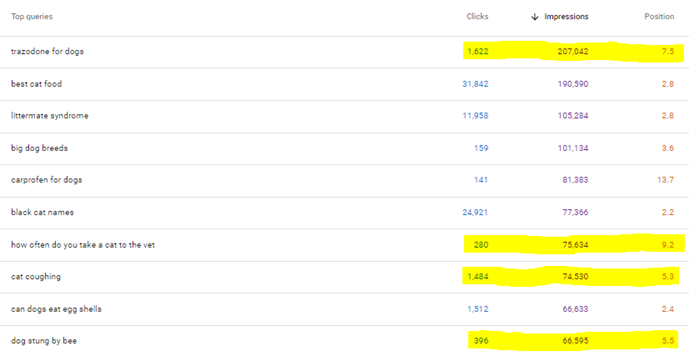
Rankings can also serve as barometers for search climate. While a more gradual rank decline might be caused by losing to the competition, a sudden decline might portray an algorithm change. Either way, catching the fall in its early stages may allow you to fix the problem faster than if you rely solely on other data points, such as traffic.


Tracking changes in rankings can also help inform other data points. For example, you might observe a traffic gain or decline with no change in rankings. In this instance, you may want to consider seasonality, news events, or other industry-specific motivators for spikes in demand.
For this reason, it’s important to check rankings regularly at a granular level, i.e., weekly or even daily (may sound daunting, but some tools can help you automate this). Monthly reports can track long-term growth at a high level, but may cause you to act too late when issues arise.
Choosing which keywords to track
Begin by identifying keywords that currently drive traffic so you can get an idea of what’s currently working. Filter this list to exclude branded keywords, so that you can focus on relevant topics with broader search appeal and audience growth opportunities. Do not focus strictly on brand name plays that may be driven primarily by efforts on other channels.
Use this list as your master source of keywords to track. It can be helpful to pull monthly search volume as part of this exercise, so you can quantify the public’s general interest associated with each term. Now you can consider what keywords are your high-value targets.
Usually, these keywords should include phrases that indicate intent to engage in your desired action, whether they intend to make a purchase, book services, register for your content, or something similar. For example, dental practices might look at terms like “dentists near me” or “root canal costs.” Comparing keyword performance to conversion rates can help you spot gaps, which may lead you to expand the keywords you target or tailor your content to better align with search intent.
Top-of-funnel keywords should also be a part of your strategy because they can directly contribute to building brand awareness and domain authority. Build a list of the phrases a user would search for before seeking your product or service. In our example, this might be, “why do I need to get my wisdom teeth removed?” Long-tail keywords can work well here if they are relevant and carry search volume.
These top-of-funnel keywords may drive even more traffic than your conversion-oriented keywords, although you should anticipate a lower conversion rate. They are more effective in building brand awareness and trust. Top-of-funnel keywords are better suited as a long-term conversion play.
When choosing target keywords, include pages that currently rank on page 1 and those with room for growth, or “striking distance” keywords. Be sure to identify keywords that represent your entire range of products and services, so you can market somewhat comprehensively while also getting data on the relative performance of your various offerings.
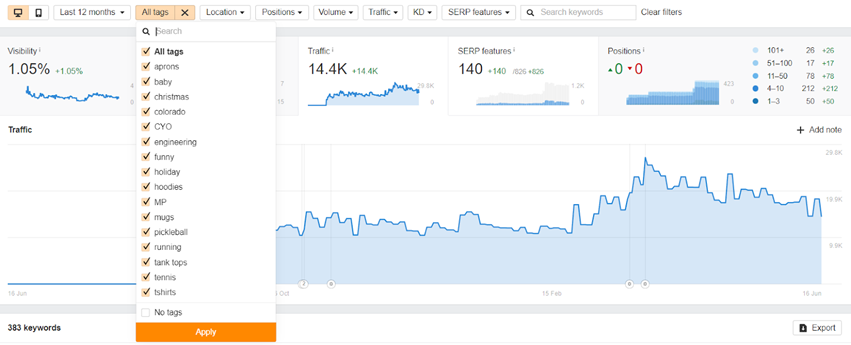
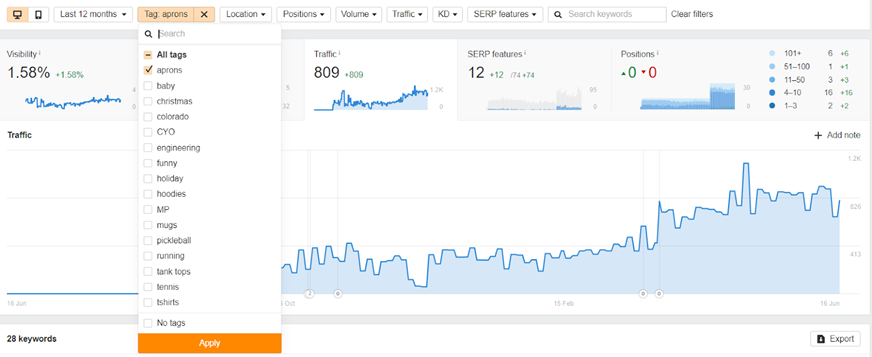
Summary: What to include in your organic SEO report
Each of these Organic Search metrics are useful for understanding different aspects of your organic visibility, but they work best when used together to create a holistic view of your performance and opportunities:
- Clicks represent actual traffic to your site driven by Organic Search. The ultimate goal of your SEO strategy should be to drive more clicks, especially for keywords that are likely to result in conversions.
- Impressions show you which keywords are in demand & within the scope of keywords you may be able to target. They’re also one of the leading indicators of a successful SEO strategy or campaign.
- Rankings help you quantify which keywords are realistic targets within your reach. This is also a key metric to monitor for keywords that already drive traffic, on a weekly or daily basis. This will allow you to nip issues in the bud, rather than waiting for a major traffic drop to show up in a monthly report.
- Click-through Rate is a consideration when prioritizing keywords and developing your strategy. Many variables contribute to a strong CTR, like user intent, SERP features, and the attractiveness of your landing page among other results. Improving your keyword rank is one of the best ways to maximize CTR, but that’s far from the only method.
A useful SEO report considers all these metrics, and displays them in a way that’s easy to understand. Of course, there’s much more data to include in a full-blown web analytics report, like traffic figures from your other marketing channels and on-site behavior once a user reaches your site. While the metrics above can all be found in Search Console, Google Analytics is a gold mine for monitoring additional traffic & engagement KPIs, which we’ll discuss in the next installment of this reporting series.
As a bonus, your reporting should be able to serve multiple functions such as:
- monitoring progress
- raising a red flag for any urgent issues
- revealing opportunities or potential next steps.
Different audiences may prioritize different functions – from hands-on SEO strategists who want to dig in and compare various opportunities to guide their strategy, to C-level executives who simply want to know if it’s working and how it affects the bottom line. As with any communication, consider your audience while building the report(s) and make the data/presentation of the data useful for their specific needs.







